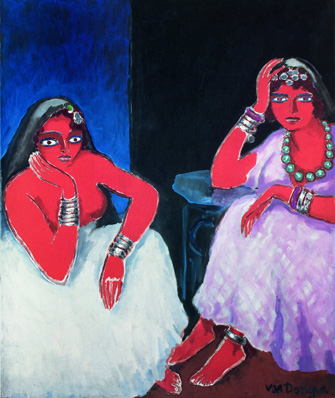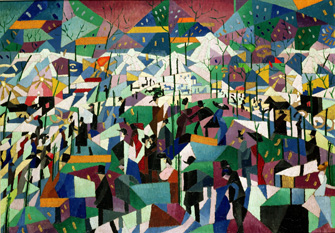
Paris is hosting exhibitions of two artists, Kees Van Dongen (1877-1968) and Gino Severini (1883-1966), whose work is unintentionally complementary. The two shared nearly identical lifespans, and each chose Paris as his home for long periods of time. Although both lived and worked in the famed Bateau Lavoir studios in Montmartre when it was the nursery for many of the art movements of the first half of the 20th century and certainly crossed paths, since they had many friends in common, among them Picasso and Modigliani, they do not seem to have been friends.

The subtitle of the exhibition at the Musée d’Art Moderne de la Ville de Paris sums up the Dutch artist pretty well: “Van Dongen: Fauve, Anarchiste et Mondain.” Think of Van Dongen and you are likely to picture extreme Fauvist color – strident, overwhelming, clashing – and portraits of women with scarily large eyes. The exhibition demonstrates that he was a much more versatile artist than that, however, with a collection of works dating from between 1895 and the early 1930s, many of them from private collections. Some of the pictures are so brightly colored that they are blinding, like “Marchande d’Herbes et d’Amour” (pictured above) with its two half-clad ladies with fiery orange-red skin and white and pink skirts against a blue and black background.
Van Dongen’s short Fauvist period followed more classical beginnings and dabblings in Impressionism. An avant-garde self-portrait, painted in 1895 when he was only 18, shows his precocious talent and willingness to experiment, as does the marvelous “La Chimère Pie (1895/1907?), a monumental painting of a rearing white horse with black spots. Capable of changing styles abruptly, he transformed himself into a neo-Impressionist in 1905.
“Mondain” is certainly a fitting description of Van Dongen, who was evidently something of a hippie before his time and a real party animal who lived the bohemian lifestyle to the hilt. And he was also apparently an anarchist, leading Picasso to dub him the “Kropotkin of the Bateau Lavoir” (Kropotkin was known as “the Anarchist Prince”). Van Dongen threw some memorable parties with his worldly and stylish companion Jasmy in a studio decorated like an Oriental palace in Montparnasse and later a posh townhouse.
The quality of the works in this show is uneven, but there are many wonderful paintings, like “Manège de Cochons,” which captures the wild movement and joy of the merry-go-round; “Le Boniment,” full of life and color; and the probably-Van Gogh-inspired “Meules” (1905), with its huge, puffy clouds, little haystack and heavy brushstrokes. The more static works from the 1920s and early 30s – when Van Dongen was the most fashionable portrait painter in Paris – with their elongated figures and grayish tones, are less interesting, at least to me, with the exception of a few, like the lively portrait of Yves Mirande (1924).

The Italian Severini is also neatly summed up by the title of his exhibition at the Musée de l’Orangerie: “Gino Severini: Futuriste et Néoclassique.” Attracted to the vibrant art scene in Paris, he arrived in 1906, already steeped in the Divisionism (Neo-Impressionism) of Giacomo Balla and Umberto Boccioni, and joined the Futurist movement in 1910. The exhibition covers the years 1903 to 1938.
The show starts off with Divisionist and Post-Impressionist works – lovely, peaceful and sun-dappled. With the arrival of Futurism, the artist’s work took on frenetic speed and energy, glowing with light and brilliant color. It wasn’t long, however, before he integrated the Cubism that was all the rage in Paris at the time into his work, but his version was brighter and more cheerful, colorful and lively than that of Picasso and Braque, his drinking buddies at the Lapin Agile in Montmartre. The colors gradually grew more somber, however, and after 1916, when Severini joined the “Return to Order” movement, neoclassicist concerns took over his work. Many of those on show here are lovely, but the effervescence is gone.
It is fascinating to see how quickly these two talented artists moved from one style to another in their youth as they absorbed the explosive artistic influences that surrounded them in Paris at the time. It is also rather sad to see their work calm down and become more sober as financial success and advancing age seemed to make their painting more conservative in expression and subject matter.
Both exhibitions examine only the early careers – the high points for both – of the two artists, and neither mentions the unsavory political associations that later tainted their reputations. Van Dongen traveled to Germany on an official trip with a group of artists (among them Maurice de Vlaminck, André Derain and a number of others) in 1941, aiding the Nazi propaganda machine, and Severini had his Fascist period after he returned to Italy for 10 years in 1935 (he returned to Paris after World War II). Today, however, all seems to have been forgiven – or at least forgotten.
Musée d’Art Moderne de la Ville de Paris: 11, avenue du Président Wilson, 75116 Paris. Métro: Alma-Marceau or Iéna. Tel.: 01 53 67 40 00. Open Tuesday-Sunday, 10 a.m.-6 p.m. (Thursday until 10 p.m.). Closed on public holidays. Admission: €10. Through July 17, 2011. www.mam.paris.fr
Musée de l’Orangerie: Jardin des Tuileries, 75001 Paris. Métro: Concorde. Tel.: 01 44 77 80 07. Open Wednesday-Monday, 9am-6pm. Admission: €7.50. Through July 25, 2011. www.musee-orangerie.fr
© 2011 Paris Update
Favorite
